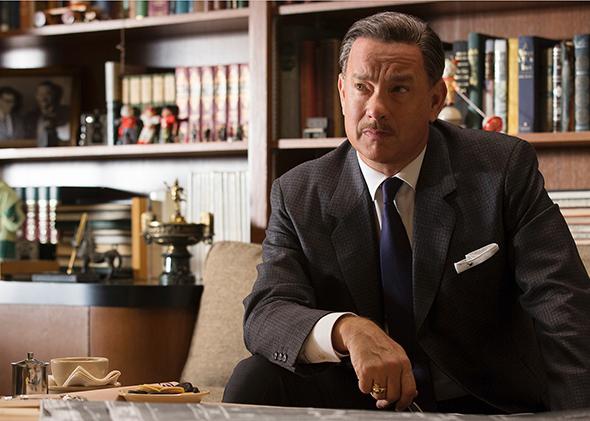It’s a pleasing coincidence that the prestige studio picture Saving Mr. Banks—a Disney release in which Walt Disney figures as a major character—came out the same year as Escape From Tomorrow, a gnarly little underground horror film that was self-financed by its director (newcomer Randy Moore) and filmed, in part, by a guerilla-style undercover film crew at Disney’s Magic Kingdom. Escape from Tomorrow (which I thought made for a better idea and poster than actual movie, though some disagreed) explored some of the unsettling fears and fantasies bound up in Americans’ lasting devotion to that ubiquitous white-gloved mouse and his well-policed, fixedly sunny utopia. Saving Mr. Banks, directed by John Lee Hancock (The Blind Side) does just the opposite: It seeks to soothe its audience, to reassure us (as Tom Hanks’ benevolent Walt Disney keeps reassuring Emma Thompson’s uptight P.L. Travers) that if we just sit back and let Disney take charge, everything will be fine.
And everything is, I guess, if you’re looking for a straightforwardly soapy comic melodrama that revisits a little-known moment in Hollywood history through a pleasantly nostalgic (and beautifully art-directed) scrim. But there’s something obscurely creepy about this movie’s attempt to rewrite P.L. Travers’ decades-long standoff with Walt Disney over the rights to Mary Poppins as a kind of sexless meet-cute rom-com, in which the twinkly eyed but iron-willed Walt slowly wins over the disapproving Mrs. Travers (as she insists on being called despite his repeated attempts to address her familiarly as “Pam.”) As the audience already knows, Disney won the standoff: Mary Poppins did eventually get made into a movie, one that was a worldwide smash upon its release in 1964 and went on to win five Academy Awards and become a children’s classic. Travers made no secret of her dislike for the finished film (although Saving Mr. Banks suggests in one key scene that she may have been dissembling). If Mary Poppins was too sentimental and pandering a movie for Travers’ taste, one trembles to imagine her reaction to Saving Mr. Banks, which uses her artistic battles with the Disney production team as an unlikely springboard to Oprah-esque self-discovery.
It’s 1961, and Travers, advised by her agent to sell the rights to Disney before she runs out of savings and loses her beloved London house, reluctantly travels to Los Angeles to have a sitdown with the film’s prospective creative team. That team consists of Disney himself, the screenwriter Don DaGradi (Bradley Whitford) and the film’s songwriters, brothers Richard and Robert Sherman (Jason Schwartzman and B.J. Novak). In their early meetings, Mrs. Travers is a nightmare: stiff-backed, snobbish, and condescending, she shoots down every idea, from the casting of Dick Van Dyke as Bert to a set design that differs in the smallest detail from the Cherry Tree Lane of her imagination. Gradually, Mrs. Travers begins to be won over by the irresistible songs the Sherman brothers are churning out by the day (we witness parts of the composition process of “A Spoonful of Sugar,” “Feed the Birds” and “Let’s Go Fly a Kite”) but she continues to hold firm on one stipulation: No animated dancing penguins, or she walks.
During those long hours in the writers’ room, Mrs. Travers needs to daydream about something, so her mind wanders to her troubled childhood in Australia (in fact, the film begins there, in the first of an endless succession of honey-hued flashbacks). Played as a little girl by Annie Rose Buckley, she was once the daughter of Travers Goff (Colin Farrell), a spontaneous and adoring but hopelessly alcoholic father whose inability to hold down a job left his family downwardly mobile and his wife (Ruth Wilson) angry and depressed.
The screenplay aims to draw a parallel between the middle-aged Mrs. Travers’ unresolved feelings toward her long-deceased father and the onscreen fate of Mr. Banks, the absentee, work-obsessed father of the children Mary Poppins takes care of. But the analogy never sticks: The overly industrious Mr. Banks bears little resemblance to the wastrel Travers Goff, who, if anything, needed to spend less time flying kites with his children. And the film’s title notwithstanding, very little time is spent on the process of developing Mr. Banks’ character, or much else in the Mary Poppins script. If the 30-plus minutes of screen time devoted to those Australia flashbacks—including multiple slo-mo father-daughter horseback rides and soulful drunken apologies from Farrell—had been spent exploring what it was like to collaborate on a script with Walt Disney, this might have been an interesting process film about the intersection between art and commerce in midcentury American entertainment. Instead, the film Mary Poppins—from which we see a few short clips in a late scene—is treated mainly as a means to an end, a stepping stone on P.L. Travers’ path toward embracing her inner child. For a movie that’s all about what a swell idea it was to adapt Mary Poppins for the screen, Saving Mr. Banks seems remarkably uninterested in what made the movie special.
I will give Saving Mr. Banks this: Its lavish production design makes life on the Disney backlot in 1961 look as candy-colored and deliciously artificial as it must have been. It features several rollicking in-studio performances of those timeless Sherman brothers songs. And it stars Emma Thompson and Tom Hanks, two beloved veteran actors who make for agreeable company even when the characters they’re playing have been purged of every quality that might have made them interesting. (P.L. Travers’ bisexuality and fascination with Eastern religions spring to mind, as does Disney’s alleged anti-Semitism and his resistance to working with women in positions of power.) But Hanks’ avuncular Disney and Thompson’s prim, fussy Travers are too idealized and bland to strike sparks either off one another or in the viewer’s imagination. Their characters lack that tincture of real-life bitterness that would help us to choke down this giant spoonful of sugar.
